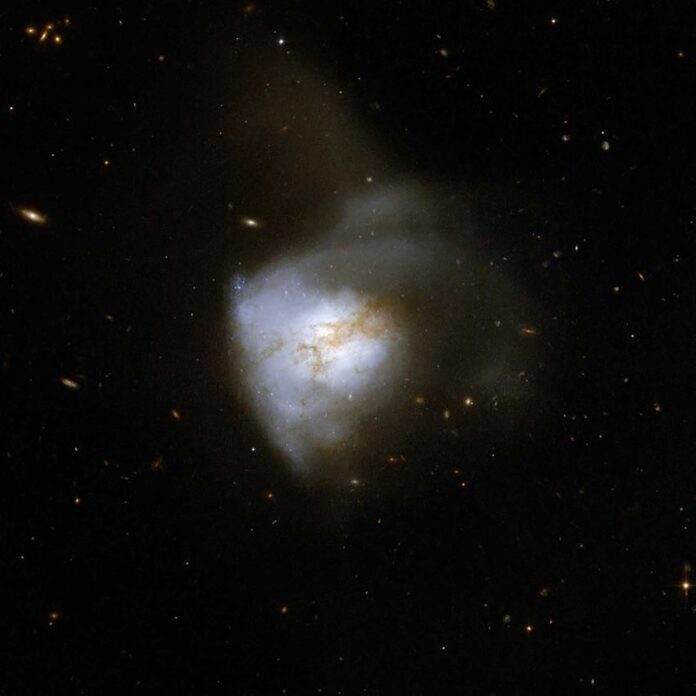
By Amit Malewar 23 Dec, 2024
Collected at: https://www.techexplorist.com/astronomers-spotted-missing-ingredient-cooking-stars/95012/
Suppose you are preparing a Christmas pudding. You have to close the lid of the pressure cooker tightly to keep the steam inside the pot, providing even heat treatment to the pudding and yielding an extra-dense, moist delicacy to be enjoyed.
It turns out that galaxies undergoing a cosmic collision perhaps also need to have a similar “weight” to develop perfunctory conditions for star formation. Astronomers have seen the missing ingredient in this composition of stellar forming for the first time: magnetic fields.
Up till now, the role of magnetic fields from the time of galaxy mergers and star formation has just been theoretical. However, the international team of scientists led by Dr. David Clements of Imperial College London, since a breakthrough, have found proof for magnetic fields associated with a disc of gas and dust several hundred light-years across deep within the system of two merging galaxies known as Arp220.
This discovery offers exciting insights into how galaxies cook stars at such startling rates.
A few hundred million light-years away, Arp220 is a tumultuous but active area where two gas-rich spiral galaxies are merging, resulting in a “starburst,” or explosion of star formation.
Starburst forms stars much quicker than other galaxies. Still, their processes have been enigmatic to astronomers-from determining why some galaxies become stars more uniquely effective than others and embarking on star-formation.
Dr. Clements and his team believe they’ve uncovered part of the answer. Just as the lid and weight on a pressure cooker keep the ingredients from boiling over, magnetic fields may stabilize galaxy mergers, preventing the intense heat from young stars and supernova explosions from quickly dispersing the star-forming gas. This, in turn, allows more stars to form in the turbulent environment of a merging galaxy.
“This is the first time we’ve found evidence of magnetic fields in the core of a galaxy merger,” said Dr. Clements. “While this is just the beginning, we now have the exciting challenge of developing better models and studying other galaxy mergers to understand the role of magnetic fields fully.”
In a way, star formation in galaxy mergers is like cooking up a batch of Christmas puddings. Astronomers need to squeeze vast amounts of gas together to create stars, just as you would pack in your ingredients for a dense, moist pudding. But as the heat builds from young stars (or the cooker’s flame), the gas can boil over, dispersing into space.
According to Dr. Clements, magnetic fields might be the crucial force that keeps everything in check, maintaining the pressure to allow star formation to continue without losing too much gas.
The team used the Submillimeter Array (SMA) on Maunakea in Hawaii to study Arp220 in unprecedented detail. The SMA observes light in millimeter wavelengths, which provides valuable insights into phenomena like the birth of stars, black holes, and molecular gas and dust.
Arp220 is one of the brightest objects in the far-infrared sky, a region where the combined light of distant galaxies and their dust emissions can be detected.
What makes Arp220 so unique is that it’s not just a typical galaxy—it’s a galactic merger that is firing up an intense wave of star creation. The researchers’ observations suggest that the magnetic fields in Arp220 are playing a critical role in maintaining the conditions needed for this extraordinary star formation.
This finding is not just a cosmic curiosity. Astronomers have long been puzzled by how some galaxies can form stars efficiently during mergers. Magnetic fields might be the key stabilizing factor, acting as an extra “binding force” that holds the star-forming gas together, resisting its tendency to dissipate under intense heat.
The team’s next step is to investigate other ultraluminous infrared galaxies using the Atacama Large Millimeter/submillimeter Array (ALMA), one of the most powerful telescopes for studying molecular gas and dust in the cool universe. With this, they aim to confirm whether magnetic fields are indeed standard in merging galaxies and how they influence the star formation process.
The discovery marks an exciting chapter in studying galaxy mergers and star formation. As researchers continue to probe the magnetic forces in galaxies like Arp220, they hope to uncover more secrets about how the most luminous and active galaxies in the universe give birth to stars at such extraordinary rates.
Astronomers can take solace in knowing that the missing ingredient for cooking up stars—much like that essential weight on a pressure cooker lid—has finally been found. The recipe for stellar creation just got a little clearer.
Journal Reference:
- D L Clements, Qizhou Zhang et al. Polarized dust emission in Arp220: magnetic fields in the core of an ultraluminous infrared Galaxy. Monthly Notices of the Royal Astronomical Society. DOI: 10.1093/mnrasl/slae107

Leave a Reply